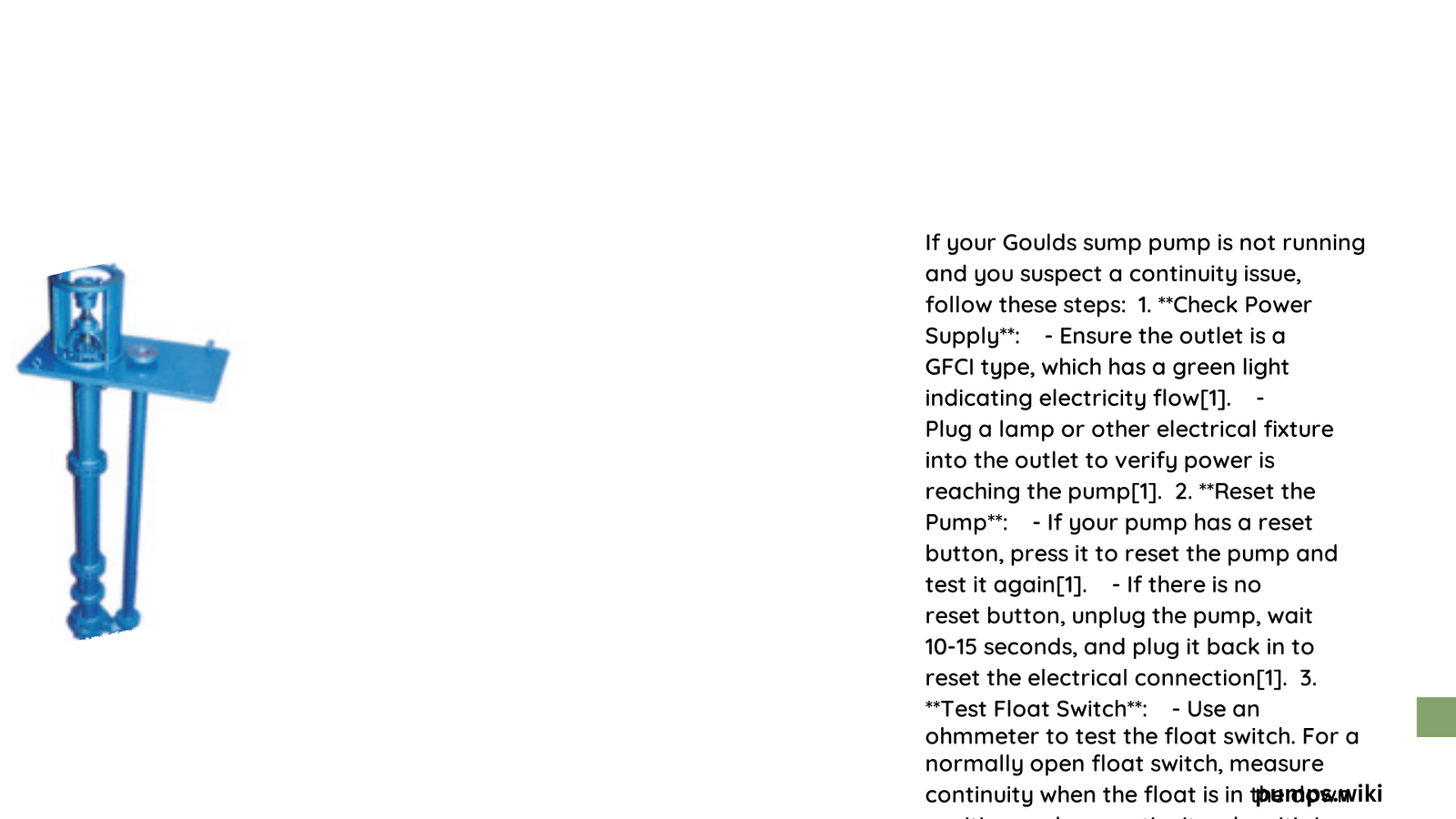When a Goulds sump pump fails to run, continuity issues are often the culprit. This comprehensive guide explores the steps to diagnose and resolve continuity problems in Goulds sump pumps. From testing procedures to common electrical issues, we’ll cover everything you need to know to get your pump running smoothly again.
What Are the Specific Continuity Test Procedures for a Goulds Sump Pump?
To accurately test the continuity of a Goulds sump pump motor, follow these steps:
- Gather necessary tools:
- Multimeter (digital or analog)
-
Pump’s wiring diagram or manual
-
Perform Line-to-Line Resistance Test:
- Ensure the pump is disconnected from power
- Set multimeter to ohms (Ω) setting
- Measure resistance between each pair of motor leads
-
Compare readings to specified values in the motor manual
-
Conduct Line-to-Ground Resistance Test:
- Set multimeter to ohms (Ω) setting
- Measure resistance between each motor lead and ground
- A good motor should show an open circuit (OL or infinity)
Expected resistance values:
– Line-to-line: Typically 10-15 Ω for a 230V motor (may vary by model)
– Line-to-ground: Should show an open circuit
What Are Common Electrical Issues and Components to Inspect?

When troubleshooting a Goulds sump pump not running due to continuity issues, consider these common problems:
- Float Switch Failure:
- Failure rate: Moderate to high
-
Symptoms: Pump doesn’t start even with high water levels
-
Circuit Breaker or Fuse Issues:
- Failure rate: Low to moderate
-
Symptoms: No power to the pump
-
Wiring Problems:
- Failure rate: Moderate
-
Symptoms: Pump doesn’t turn on or operates intermittently
-
Motor Winding Issues:
- Failure rate: Low
- Symptoms: Pump doesn’t start or makes unusual noises
Components to inspect:
– Float switch
– Circuit breaker/fuse
– Wiring
– Motor windings
How to Perform a Step-by-Step Troubleshooting Process?
Follow this systematic approach to troubleshoot your Goulds sump pump:
- Safety Check (5 minutes):
- Ensure no power to the motor
-
Verify pump disconnection from power source
-
Visual Inspection (10 minutes):
- Check wiring for damage or poor connections
-
Inspect circuit breaker or fuse
-
Float Switch Test (10 minutes):
- Use ohmmeter to test float switch continuity
-
Verify correct operation in up and down positions
-
Line-to-Line Resistance Test (15 minutes):
- Measure resistance between motor lead pairs
-
Compare to specified values
-
Line-to-Ground Resistance Test (15 minutes):
-
Check for ground faults by measuring lead-to-ground resistance
-
Control Box Component Inspection (20 minutes):
- Test overload, capacitor, relay coil, and magnetic contactor
Potential replacement costs:
– Float switch: $20-$50
– Wiring repairs: $50-$200
– Motor replacement: $200-$1,000+
– Control box replacement: $100-$500+
How to Diagnose Continuity Problems?
Understanding continuity test results is crucial for accurate diagnosis:
Types of Continuity Tests:
- Line-to-Line Resistance
- Line-to-Ground Resistance
Acceptable Continuity Ranges:
- Line-to-Line: Typically within a few ohms (e.g., 10-15 Ω for 230V motor)
- Line-to-Ground: Should show open circuit (OL or infinity)
Interpreting Results:
| Reading | Interpretation |
|---|---|
| Normal Line-to-Line | Motor windings and wiring intact |
| Low Line-to-Line | Shorted winding |
| High Line-to-Line | Open winding |
| Low Line-to-Ground | Ground fault |
By following these steps and understanding the results, you can effectively diagnose and resolve continuity issues in your Goulds sump pump, ensuring it runs reliably when needed.
References:
1. How to Test a Pump Float Switch
2. How to Troubleshoot Submersible Motors with Your Ohmmeter
3. Multi-Meter Testing of Submersible Pump Motors
